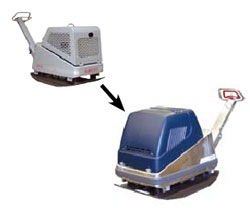Longer lasting soil compactors
What trigger is the company responding to?
About 90% of its customers are rental companies so the end user rarely owns the product. Several of its competitors have a strategy of developing cheaper products and making their profit on spare parts. Swepac's strategy is to have products of good quality, lasting for a long time and needing little maintenance. Its products are scheduled to be refurbished after three years, and then returned to Swepac after five to six years of use, when they are fully reconditioned and sold.
What was the response?
Swepac initiated an ecodesign project, involving an industrial designer, to redevelop the products and the range of services they offer. The ability to use the products as part of their rental service offering was a prerequisite for the design, which also included considerations such as maintenance and weight.
From an environmental perspective it was important that the compactors should be designed to facilitate maintenance. For example, the products' hydraulic system does not need to be opened during its lifetime, unless it needs to be repaired. This avoids the possibility of oil leakage during maintenance.

Another design change involved choosing materials to keep the product looking new, as studies had shown that users were more careful when handling products that looked pristine. A different material was used to make the cover and the product was left unvarnished as the varnish had a tendency to wear off. The need to recycle products at the end of their life also influenced the choice of materials.
Bottom line benefits
The company sees environmental performance as a key selling point for its customers. It also wants to be ready for future demands on environmental performance. The new design facilitates maintenance and refurbishment and the products look fresh. The company has won design awards.
Wider lessons
It is important to consider the design of a product, including product architecture and choice of materials, when optimising technical solutions in relation to the business model and product's use. In Swepac's case design changes made the product easier to maintain and look more attractive. The ecodesign project was seen as a key factor in the company's success.
Case study sources
Case study provided by Professor Margareta Norell Bergendahl Lloyd and Dr Gunilla Ölundh Sandström (Kings Technical School, Sweden)
http://www.swepac.com/









